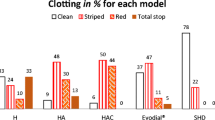Summary
The purpose of our study was to check whether the dosage recommended for the low molecular weight heparin tested here, i.e., 50% of the corresponding unfractionated heparin dose, is adequate to prevent clot formation in the extracorporeal system. Sixteen dialysis treatments of 4–5 h were given to each of six chronic dialysis patients. In dialyses 1, 2, 15 and 16 unfractionated heparin (initial dose 35 IU/kg, continuous dose 20 IU/kg/h) was given, and in dialyses 3–14 low molecular weight heparin (initial dose 17.5 anti-Xa U/kg, continuous dose 10 anti-X U/kg/h). At these dose levels of low molecular weight heparin, clot formation occurred in the extracorporeal system in five of the six patients, despite the fact that the plasma anti-Xa level of 0.5 U/ml recommended by the manufacturer had been attained. For this reason the continuous dose of low molecular weight heparin had to be raised to approx. 80% of the corresponding continuous dose of unfractionated heparin. A plasma anti-Xa level of 0.7 U/ml is necessary to prevent extracorporeal clot formation.
Similar content being viewed by others
Abbreviations
- anti-Xa U:
-
Anti-factor Xa unit
- aPTT:
-
Activated partial thromboplastin time
- AT III:
-
Antithrombin III
- IU:
-
International unit
- LMWH:
-
Low molecular weight heparin
- UFH:
-
Unfractionated heparin
References
Andersson LO, Barrowcliffe TW, Holmer E, Johnson EA, Sims GEC (1976) Anticoagulant properties of heparin fractionated by affinity chromatography on matrix-bound antithrombin III and by gel filtration. Thromb Res 9:575–583
Bratt G, Törnebohm E, Lockner D, Bergström K (1985) A human pharmacological study comparing conventional heparin and a low molecular weight heparin fragment. Thromb Haemost 53:208–211
Carter CJ, Kelton JG, Hirsh J, Gent M (1981) Relationship between the antithrombotic and anticoagulant effects of low molecular weight heparin. Throm Res 21:169–174
Holmer E, Mattsson C, Nilsson S (1982) Anticoagulant and antithrombotic effects of heparin and low molecular weight heparin fragments in rabbits. Thromb Res 25:475–485
Lane DA, Flynn A, Ireland H, Anastassiades E, Curtis JR (1986) On the evaluation of heparin and low molecular weight heparin in haemodialysis for chronic renal failure. Haemostasis [Suppl 2]16:38–47
Schrader J, Valentin R, Tönnis HJ, Hildebrand U, Stibbe W, Armstrong VW, Kandt M, Köstering H, Quellhorst E (1985) Low molecular weight heparin in hemodialysis and hemofiltration patients. Kidney Int 28:823–829
Yin ET, Stockhausen DC (1985) Appraisal of clot-based and amidolytic anti-Xa methods for the monitoring of heparin and its derivates. Semin Thromb Hemost 11:243–244
Yin ET, Wessler S, Butler JV (1973) Plasma heparin: a unique practial, submicrogram-sensitive assay. J Lab Clin Med 81:298–310
Author information
Authors and Affiliations
Rights and permissions
About this article
Cite this article
Maurin, N., Kierdorf, H. A low molecular weight heparin in hemodialysis. Klin Wochenschr 66, 246–249 (1988). https://doi.org/10.1007/BF01748164
Received:
Accepted:
Issue Date:
DOI: https://doi.org/10.1007/BF01748164




